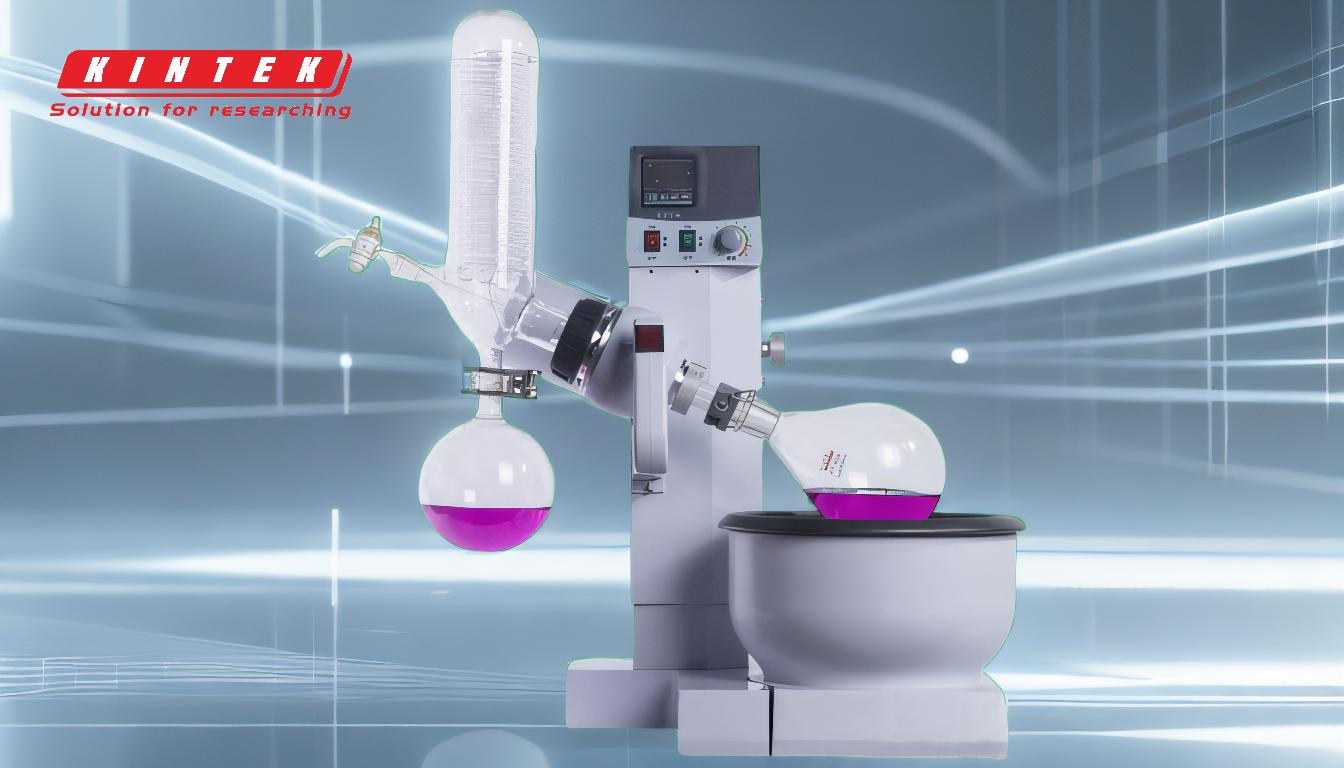Rotary evaporation, often referred to as rotovap distillation, is a technique used to separate solvents from compounds by leveraging differences in boiling points under reduced pressure. It is widely employed in laboratories and industries for tasks such as solvent recovery, sample purification, and concentration of solutions. The process involves rotating a flask containing the solution to increase its surface area, applying gentle heat, and reducing pressure to lower the boiling point of the solvent, enabling efficient evaporation. This method is particularly useful for volatile solvents, essential oil extraction, and preparing samples for further analysis. Its versatility makes it a staple in fields like chemistry, pharmaceuticals, and food science.
Key Points Explained:

-
Definition and Purpose of Rotary Evaporation:
- Rotary evaporation, or rotovap distillation, is a technique used to separate solvents from compounds by evaporating the solvent under reduced pressure.
- It is particularly effective when the desired compound has a lower boiling point than the solvent and does not form an azeotrope with it.
- The primary purpose is to purify samples, recover solvents, concentrate solutions, and extract essential oils or flavors.
-
Components and Working Principle:
- A rotary evaporator consists of a rotating flask, a heating bath, a condenser, and a vacuum pump.
- The solution is placed in a round-bottom flask, which is rotated to increase the surface area of the liquid, promoting faster evaporation.
- Gentle heat is applied through a heating bath, and the pressure is reduced using a vacuum pump to lower the boiling point of the solvent.
- The evaporated solvent is condensed and collected in a separate flask, while the desired compound remains in the original flask.
-
Applications of Rotary Evaporation:
- Solvent Recovery: Efficiently recovers solvents for reuse, reducing waste and costs.
- Sample Purification: Removes impurities or unwanted substances from samples, such as in drug development or chemical synthesis.
- Concentration: Concentrates solutions by removing excess solvent, often used in food science or pharmaceutical preparation.
- Essential Oil Extraction: Extracts volatile oils from plants or natural sources at low temperatures to preserve their properties.
- Distillation: Separates volatile components from mixtures, such as concentrating flavors or removing odors.
-
Advantages of Rotary Evaporation:
- Efficiency: The rotation of the flask increases evaporation rates, making the process faster and more efficient.
- Low-Temperature Operation: Reduced pressure allows solvents to evaporate at lower temperatures, preventing thermal degradation of heat-sensitive compounds.
- Versatility: Suitable for a wide range of applications, including distillation, crystallization, drying, and solvent recycling.
- Scalability: Can be used for small-scale laboratory experiments or scaled up for industrial processes.
-
Process Optimization:
- Rotation Speed: Adjusting the rotation speed of the flask ensures optimal surface area exposure for efficient evaporation.
- Temperature Control: Maintaining gentle heat prevents boiling or splashing, ensuring smooth evaporation.
- Vacuum Pressure: Proper adjustment of vacuum pressure is crucial to achieve the desired evaporation rate without compromising the integrity of the sample.
-
Industries and Fields Utilizing Rotary Evaporation:
- Pharmaceuticals: Used for drug development, purification, and solvent recovery in bio-pharmaceutical applications.
- Chemistry: Essential for chemical synthesis, compound separation, and solvent recycling.
- Food Science: Extracts flavors, concentrates solutions, and removes unwanted odors or tastes.
- Natural Product Extraction: Extracts essential oils, plant extracts, and other natural compounds.
-
Limitations and Considerations:
- Azeotropes: Not suitable for separating solvents that form azeotropes with the desired compound.
- Heat Sensitivity: While low-temperature operation is an advantage, extremely heat-sensitive compounds may still require alternative methods.
- Equipment Cost: High-quality rotary evaporators can be expensive, though their efficiency and versatility often justify the investment.
In summary, rotary evaporation is a versatile and efficient technique for separating solvents from compounds, widely used in laboratories and industries. Its ability to operate at low temperatures and under reduced pressure makes it ideal for applications ranging from solvent recovery to essential oil extraction. By understanding its working principles, advantages, and limitations, users can optimize the process for their specific needs.
Summary Table:
| Aspect | Details |
|---|---|
| Definition | Technique to separate solvents from compounds under reduced pressure. |
| Key Components | Rotating flask, heating bath, condenser, vacuum pump. |
| Applications | Solvent recovery, sample purification, essential oil extraction, and more. |
| Advantages | Efficient, low-temperature operation, versatile, scalable. |
| Industries | Pharmaceuticals, chemistry, food science, natural product extraction. |
| Limitations | Not suitable for azeotropes, equipment cost, heat sensitivity considerations. |
Discover how rotary evaporation can optimize your lab processes—contact us today for expert advice!









